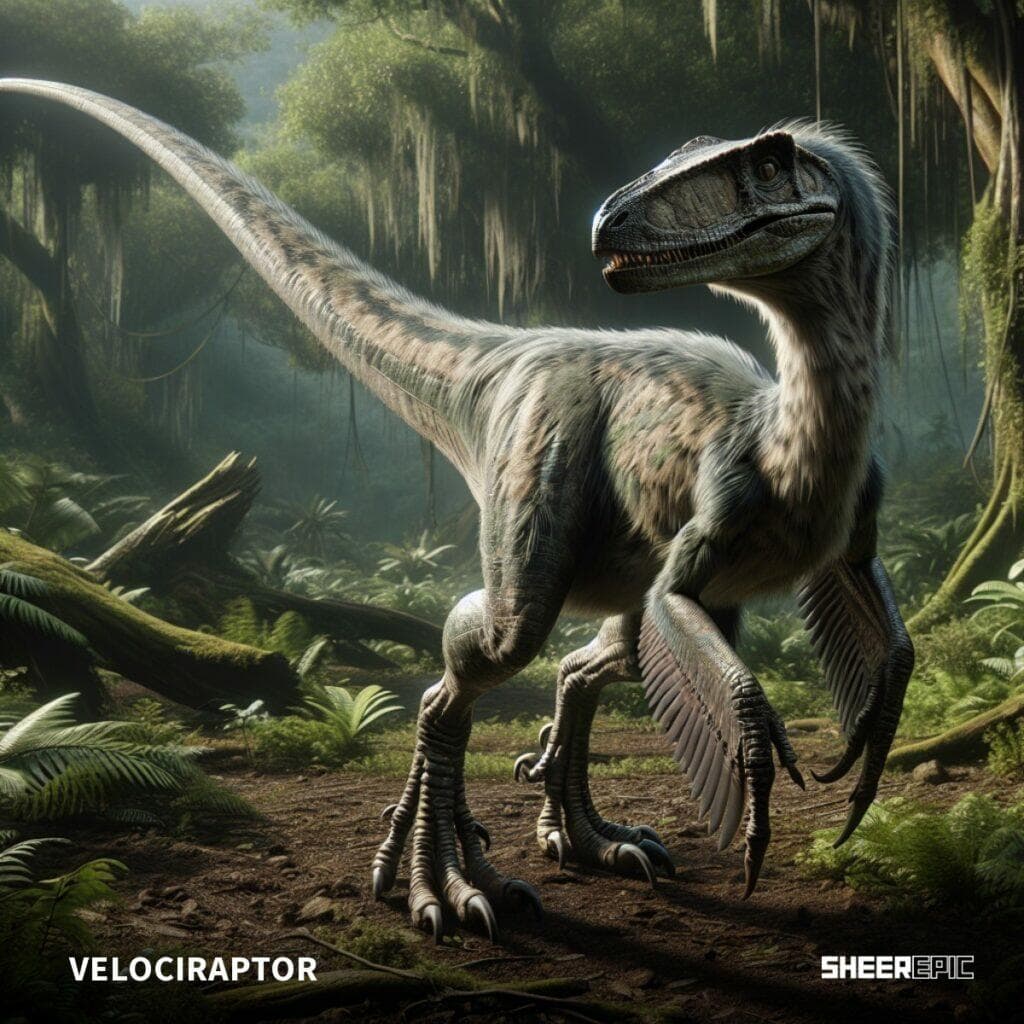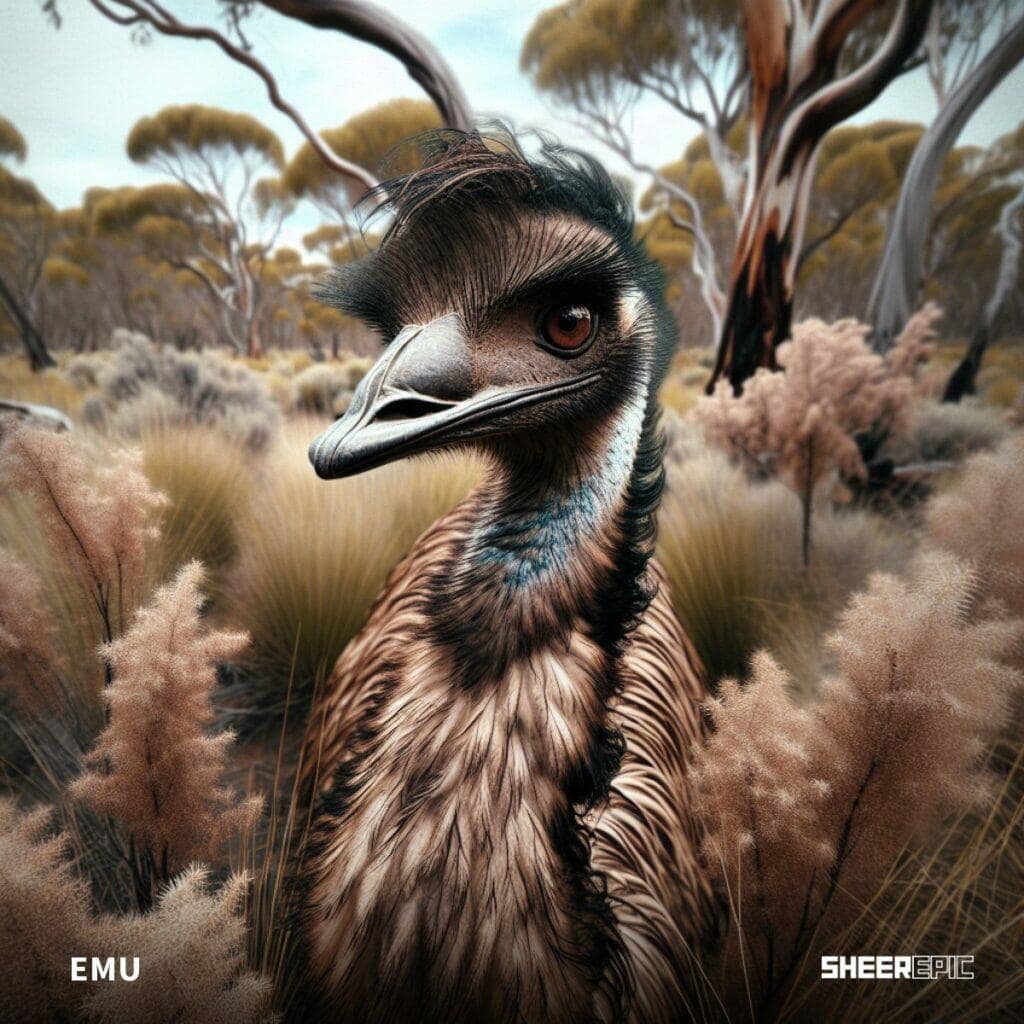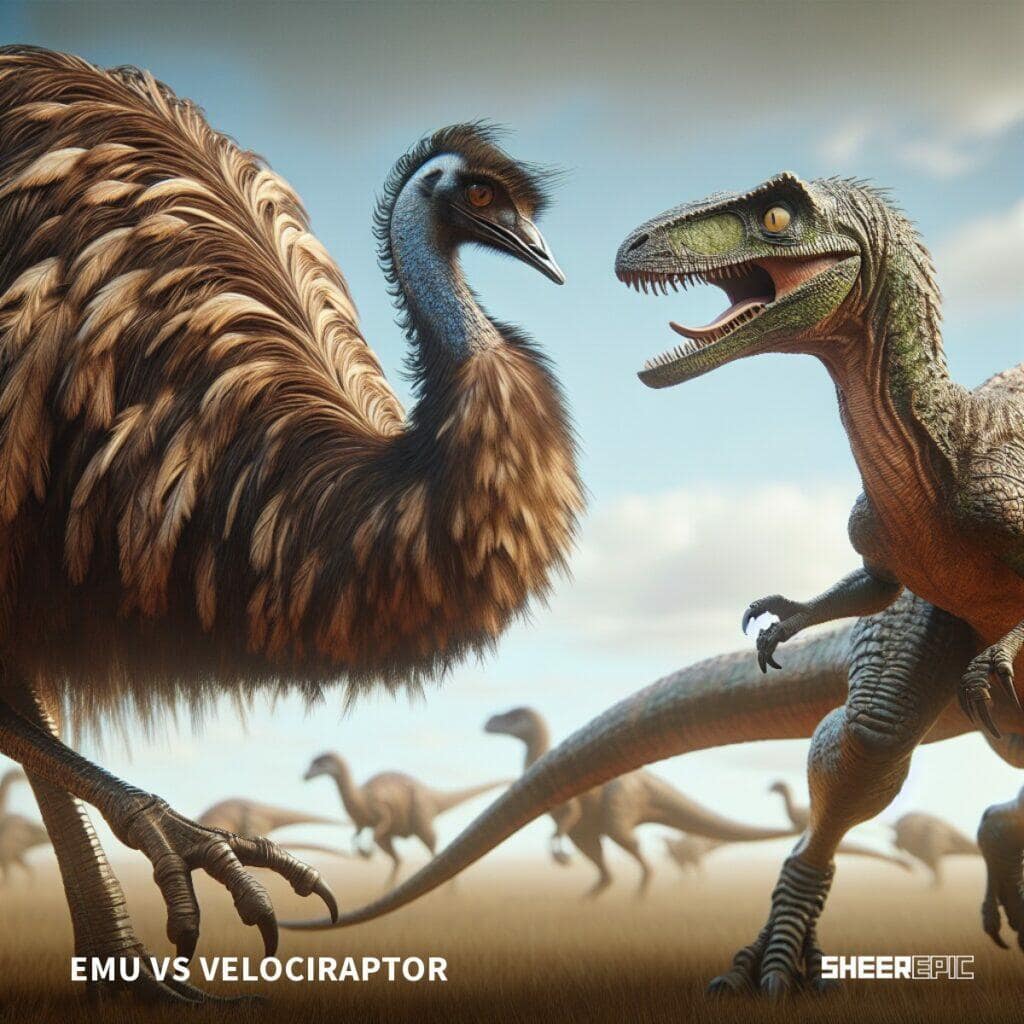The intriguing concept of a battle between the prehistoric Velociraptor and the modern Emu has captured the imagination of many. Considering various aspects such as physical characteristics, defense mechanisms, and intelligence, we can attempt to determine the outcome of such an encounter.

The Velociraptor, a small dromaeosaurid dinosaur, roamed Asia during the Late Cretaceous period around 75 to 71 million years ago.

On the other hand, the Emu, a large flightless bird endemic to Australia, is considered to be the second-tallest living bird after the ostrich.
While both animals share a common ancestry with the family of bird-like dinosaurs, the vast differences in their sizes, hunting methods, and environments could play a significant role in the outcome of a hypothetical battle. By comparing and contrasting their physical attributes, defensive skills, and social behaviors, we can gather insights into how each animal would fare in a showdown.
Key Takeaways
- Velociraptors and Emus share a common ancestral lineage but have evolved with distinct characteristics and habitats.
- Physical attributes, hunting methods, and defensive skills would play key roles in determining a hypothetical battle’s outcome.
- Analyzing intelligence and social behaviors of both animals can provide additional insights into their chances of success in a confrontation.
Table of Contents
Comparison
Comparison Table
| Attribute | Emu | Velociraptor |
|---|---|---|
| Size | 6.2 ft (1.9 m) tall | 2 ft (0.6 m) tall, 6 ft (1.8 m) long |
| Weight | 66 to 121 lbs (30 to 55 kg) | 33 lbs (15 kg) |
| Speed | 31 mph (50 km/h) | 24 mph (39 km/h) |
| Habitat | Australia | Late Cretaceous Asia |
The Emu and the Velociraptor are two entirely different creatures, both in terms of size and time period. Emus are large, flightless birds native to Australia, while Velociraptors were small, feathered therapod dinosaurs that lived in Asia during the Late Cretaceous epoch, roughly 75 million to 71 million years ago.
In terms of size, the Emu is significantly larger than the Velociraptor. Emus can stand up to 6.2 feet tall and weigh between 66 to 121 lbs, with their height and weight mainly depending on their age and sex. On the other hand, Velociraptors were only about 2 feet tall at the hip and 6 feet long, with an estimated weight of around 33 lbs.
When comparing their speed, the Emu would have the advantage in a hypothetical fight. Emus can reach speeds of up to 31 mph, while velociraptors were likely slower, with an estimated top speed of 24 mph. It’s important to note that these speeds are based on calculations and fossil evidence, as velociraptors are long extinct.
Differences in habitat would also play a role in any potential fight between these two creatures. While Emus are native to the diverse environments of Australia, including forests, grasslands, and savannas, velociraptors lived in Late Cretaceous Asia, which consisted of a variety of environments such as deserts, floodplains, and forests.
Physical Characteristics
The Velociraptor and the Emu are both interesting creatures with unique physical attributes. While the Velociraptor is a small, carnivorous dinosaur that lived approximately 75 to 71 million years ago in Asia, the Emu is a large, flightless bird native to Australia, and one of the tallest living birds today.
In terms of size, Velociraptors were relatively small dinosaurs, with an average length of about 2 meters and a height up to 0.6 meters at the hip. They are estimated to have weighed about 15-20 kilograms. The Emu, on the other hand, is considerably larger, with adult males reaching heights of up to 1.9 meters and weighing approximately 50 kilograms.
Both Velociraptors and Emus have a unique form of locomotion: bipedal striding. The Velociraptor had elongated hind limbs, well-suited for fast movement and hunting. Its iconic claw on the second toe was likely used as a weapon for slashing prey. Emus, like other ratites, such as the ostrich and cassowary, also move bipedally – their long, strong legs allow them to reach speeds of up to 48 kilometers per hour.
Feathers have been reported in some fossil samples of Velociraptors, though their coverage was likely not as extensive as modern birds. The Emu, being a bird, has feathers covering its body. The feathers play a significant role in helping the Emu maintain its body temperature in the Australian climate.
One striking difference between the two is their method of acquiring food. Velociraptors were carnivores, with sharp teeth adapted for tearing flesh. In contrast, Emus are omnivores, primarily consuming plants but occasionally feeding on insects.
Diet and Hunting
The Velociraptor was a small predatory dinosaur that lived during the Late Cretaceous period. As a dromaeosaurid, it was well-equipped for hunting its prey. With sharp claws and agile movements, it was a strong predator in its ecosystem. Velociraptor’s diet mainly consisted of smaller animals and possibly scavenged carcasses.
One of the most notable hunting techniques employed by the Velociraptor was the use of its sickle-shaped claw on its hind legs for pinning down prey. This allowed the raptor to effectively immobilize its victims, such as Protoceratops, while its powerful jaw inflicted fatal bites. It is believed that the Velociraptor primarily hunted alone, relying on speed and stealth to catch its prey.
On the other hand, the Emu is a large, flightless bird native to Australia. Although not a predator like the Velociraptor, the Emu has a diverse diet consisting of plants, insects, and small vertebrates. Being an omnivore, it is not adapted for predatory behavior, and its strength is focused more on sprinting and endurance rather than hunting and subduing prey.
In comparing the Velociraptor and the Emu, it becomes clear that the Velociraptor was a more skilled and powerful hunter, benefiting from its strong and specialized adaptations for predation. Meanwhile, the Emu’s diet and hunting abilities are less aggressive and more focused on foraging and feeding on vegetation and insects.
Defense Mechanisms
Emus and velociraptors, though separated by millions of years, exhibit distinct defense mechanisms that would play crucial roles in a hypothetical confrontation.
Emus are large flightless birds native to Australia, equipped with powerful legs and strong feet for running at high speeds. Their long, muscular legs not only facilitate rapid movement but also serve as effective weapons for kicking and warding off predators. In addition to their strong legs, emus possess sharp claws that further enhance their defensive capabilities.
On the other hand, velociraptors were small dromaeosaurid dinosaurs that lived in Asia during the Late Cretaceous epoch, around 75 million to 71 million years ago. Known for their agility and swiftness, velociraptors were carnivorous predators armed with sharp teeth, long, curved claws, and a stiff, feathered tail that helped in maintaining balance during quick movements and attacks. The most distinctive feature of a velociraptor is its sickle-shaped claw on its second toe, which could inflict deep lacerations while hunting or fending off opponents.
In terms of agility, velociraptors have a clear advantage due to their smaller size and feathery body, allowing swift and dynamic movements. Their offensive capabilities would be enhanced by their sharp, serrated teeth, indicating a well-adapted predator suitable for tearing through flesh.
Comparing these two ancient creatures in terms of their defenses showcases an interesting contrast in their survival strategies, with the emu relying on its powerful legs and physical size, while the velociraptor employs its agile body, sharp teeth, and tactical claws to its advantage.
Intelligence and Social Behavior
Velociraptors, a genus of small dromaeosaurid dinosaurs, lived during the Late Cretaceous epoch in Asia, about 75 million to 71 million years ago (Wikipedia). As part of the dinosaur family, these raptors shared certain traits with modern birds, particularly in terms of intelligence and social behaviors.
Birds are known for their ability to recognize mates, siblings, and young, which requires individual identification (Bird intelligence – Wikipedia). As such, it can be inferred that velociraptors may have had a similar level of intelligence, allowing them to interact with group members and communicate effectively. This communication would have been crucial for hunting and protection, as many dinosaurs relied on cooperative techniques.
Crows, a modern example of avian intelligence, are known to remember the individuals who observed them catching food and are also known to steal food caught by others, which hints at their ability to learn from observation (Bird intelligence – Wikipedia). This concept, called emulation learning, could have also been present in velociraptors to some extent. The adaptability to learn from others within their social structure would have given velociraptors an edge over other less intelligent dinosaurs.
Emus are large, flightless birds native to Australia, known for their strong, fast running abilities. Compared to velociraptors, emus exhibit less advanced intelligence and social structures. For instance, they do not showcase the same level of problem-solving skills or communicative abilities as seen in certain bird species.
In comparing velociraptors and emus, it is essential to consider their distinct environments and physical features. Velociraptors were significantly smaller, with a length of less than a meter, but were equipped with sharp claws and teeth (Bambiraptor – Wikipedia). Emus, on the other hand, rely on their size and speed for defense and hunting.
Taking into account the potential for observational learning and social behaviors in velociraptors, it can be inferred that these dinosaurs may have been more intelligent in terms of problem-solving and adaptation among members of their social groups. While it is impossible to accurately predict the outcome of a face-off between a velociraptor and an emu, understanding their respective intelligence levels and social behaviors allows for a more informed discussion on the matter.
Key Factors
When comparing the Emu and the Velociraptor, it’s essential to examine their various physical characteristics, diet and hunting abilities, defense mechanisms, and intelligence and social behavior to evaluate the potential outcome of a battle between the two.
First, let’s consider their physical characteristics. Emus are large, flightless birds reaching up to 1.9 meters (6.2 ft) in height and weighing around 60 kg (132 lbs). They are known for their powerful legs, which allow them to sprint at speeds of up to 50 km/h (31 mph). On the other hand, Velociraptors were small dromaeosaurid dinosaurs that lived in Asia during the Late Cretaceous epoch, about 75 million to 71 million years ago. They were much smaller than Emus, with adults reaching an average length of 2 meters (6.6 ft) and a weight of around 15 kg (33 lbs). Their most notorious feature was the sickle-shaped claw on their second toe, which they possibly used for hunting and climbing.
Regarding diet and hunting capabilities, Emus are primarily herbivorous, consuming a wide variety of plants, fruits, and insects. They are not hunters and lack sharp claws or teeth for attacking prey. In contrast, Velociraptors were carnivorous predators, primarily preying on small reptiles, mammals, and possibly other dinosaurs. They were agile hunters, using their sharp teeth and sickle-shaped claws to subdue and kill their prey.

As for defensive mechanisms, Emus can use their strong legs and sharp toenails to kick predators and defend themselves. Moreover, they have robust bodies covered in dense, shaggy feathers that might provide some protection against attacks. Velociraptors had relatively slender bodies, but their most significant defensive asset was their agility, which allowed them to escape from threats at high speeds.
Lastly, in intelligence and social behavior, Emus are considered to have a comparatively low level of cognitive ability compared to other bird species. They are social animals, usually forming small groups for foraging and protection. Velociraptors, on the other hand, are believed to have been intelligent and possibly social animals. Some paleontologists speculate that they may have hunted in packs and communicated with each other, similar to modern-day wolves.
Taking these key factors into account, it becomes apparent that both Emu and Velociraptor possess their own strengths and weaknesses, making it challenging to hypothesize a clear winner in a hypothetical battle between them.
Who Would Win?
In a hypothetical match-up between a Velociraptor and an Emu, there are several factors to consider when determining the potential winner.
Velociraptor was a small, carnivorous dinosaur that lived around 75 million to 71 million years ago during the Late Cretaceous epoch. This raptor was known for its quick, agile movements and sharp claws, which could be used as effective weapons. It is believed they were also pack hunters, able to coordinate attacks on larger prey.
On the other hand, the Emu is a large, flightless bird native to Australia, and it is the second-tallest bird in the world after the ostrich. While not a predatory creature, emus do have strong legs that can deliver powerful kicks when threatened. Emus are also known for their impressive speed, which they use primarily to escape predators or cover vast distances in search of food.

While examining these two contenders side by side, we see that the Velociraptor had the advantage of its predatory instincts, sharp claws, and teeth. The Emu, on the other hand, has impressive speed, endurance, and strong legs that could potentially inflict serious damage. However, the Emu is not a predator by nature, which could put it at a disadvantage in a life-or-death struggle.
Comparing these creatures in a hypothetical battle can be a way to deepen our understanding of the natural world, allowing us to accumulate and share seemingly pointless knowledge. Such discussions can also stoke the imagination, prompting engaging conversations and fostering curiosity.
Although the Velociraptor and Emu existed in drastically different time periods and environments, their hypothetical confrontation can be likened to a gladiator’s sword fighting against modern wildlife. Conjecturing these two creatures in a battle can provide a unique lens through which we continue to learn more about their individual characteristics and inherent strengths.
Frequently Asked Questions
How do the physical attributes of emus and velociraptors compare?
Emus are the second-tallest living birds, with a height of up to 6.2 feet, and are endemic to Australia. They have long necks, strong legs, and small vestigial wings. In contrast, velociraptors were small, agile dinosaurs living around 75 million to 71 million years ago in Asia. They had a length of 6.8 feet and were around 1.6 feet tall at the hip, with feathery bodies and sharp, curved claws on their feet.
What are the strengths and weaknesses of an emu vs. a velociraptor?
Emus have strong legs, allowing them to run at speeds of up to 30 mph, but lack in both offensive and defensive traits. Velociraptors, on the other hand, were swift predators with sharp teeth and a large, retractable sickle-shaped claw on each foot for attacking prey. However, their smaller size may have limited their strength compared to larger predators.
How does the size of an emu compare to a velociraptor?
An emu is notably larger than a velociraptor in terms of height, as previously mentioned, while their lengths are somewhat comparable. Emus can reach a height of 6.2 feet and weigh between 66 and 100 pounds, whereas velociraptors were roughly 1.6 feet tall at the hip and weighed around 33 pounds.
What are the hunting strategies of emus and velociraptors?
Emus are primarily herbivores, preferring to forage on fruits, seeds, and occasionally insects. They do not actively hunt for prey, as their diet consists mainly of plant-based foods. Velociraptors, on the other hand, were carnivorous hunters, using their sharp claws and teeth to attack and dispatch their prey. They may have worked in groups to pursue and capture small-to-medium-sized prey.
Do emus and velociraptors have any similar prey or predators?
Given the difference in time periods and geographical locations, emus and velociraptors are unlikely to share any common prey or predator species. Emus mainly feed on plant material, while velociraptors were carnivorous hunters. Additionally, emus have few natural predators in modern-day Australia, while velociraptors faced larger predators like larger theropod dinosaurs during their time.
In a hypothetical battle, what factors would determine the victor between an emu and a velociraptor?
In a hypothetical encounter, several factors would play a role in determining the outcome, such as size, agility, and weaponry. The emu’s larger size and ability to run at high speeds may work to its advantage for evasion. However, the velociraptor’s sharp teeth and sickle-shaped claws, along with its agility, make it a formidable opponent. The outcome would likely depend on the specific circumstances and individual traits of each combatant.


